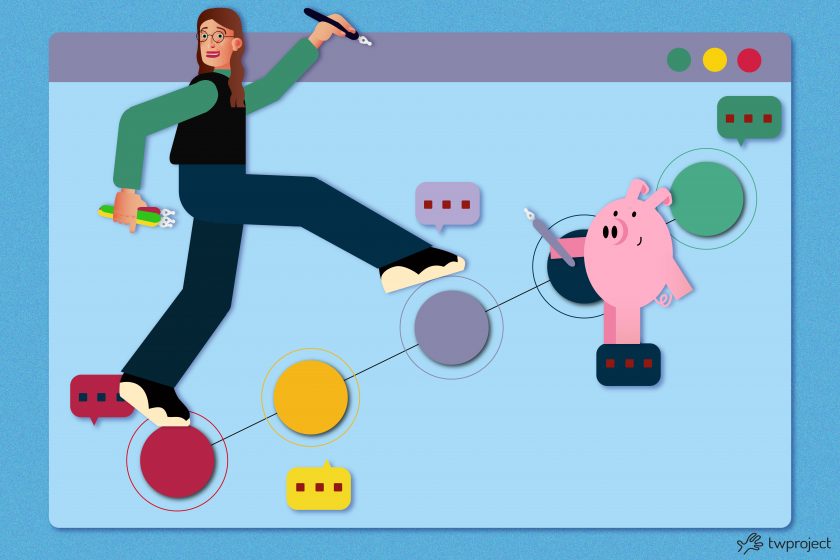Writing a well-structured project proposal is a crucial step when starting a new project.
Whether you seek approval from a client, a manager, or a stakeholder team, an effective proposal can make all the difference between success and failure.
In this article, we will examine how to write a project proposal, what elements to include, and share practical examples and proposal templates from which to draw inspiration.
CONTENT
- What is a project proposal?
- Why is a well-written proposal important?
- Project proposal structure
- How to write a project proposal step by step
- Step 1: Understanding your client’s needs
- Step 2: Preliminary research and analysis
- Step 3: Structure definition and data collection
- Step 4: Drafting
- Step 5: Review and improvement
- Step 6: Internal validation and approval
- Step 7: Submission and presentation
- Step 8: Follow-up and response
- Project proposal example
What is a project proposal?
First, it is important to understand what a project proposal is. It is a formal document that details the work to be accomplished, the goals to be achieved, the resources needed, the schedule, and the estimated costs.
The project proposal is used to get approval, budget, and alignment among all parties involved.
Why is a well-written proposal important?
A well-formulated proposal can be central to the success of any project effort. It is not only a helpful tool for gaining approval and funding, but it is also the first point of contact between the proposer and the evaluator.
An effective proposal must be clear, comprehensive, and persuasive.
Let’s take a more in-depth look at why it is so crucial:
- Convince stakeholders and funders: A well-written proposal can convey confidence, demonstrate competence, and show in a concrete way how goals will be achieved. Decision makers want to see a credible, well-articulated plan with measurable impact.
- Communicate expectations clearly: Defining goals, deadlines, costs, and the scope of the project prevents ambiguity and misunderstandings between parties. This also helps in future operational management and outcome evaluation.
- Prevent future misunderstandings: Documenting the client’s needs, required resources, constraints, and basic assumptions in detail allows for a shared and stable baseline.
- Save time: A good proposal eliminates time-consuming clarifying discussions, multiple revisions, and slowdowns due to missing or inaccurate information. Also, the drafting process becomes more efficient with a standardized structure and proposal templates.
- Establish team credibility: A clear vision supported by data, planning, and risk analysis communicates professionalism and management skills. This can make the difference between your proposal and a competitor’s.
Project proposal structure
A well-ordered project proposal follows a logical and coherent structure that makes it easy for stakeholders to understand and evaluate. It aims to effectively communicate all the information needed to justify, plan, and implement the proposed project.
A clear structure helps save time, improve communication, and reduce the likelihood of errors or misunderstandings. Below, we will analyze each key section, explaining its importance and providing practical guidance on what to include:
1. Executive summary
The executive summary is by far the most important part of the proposal, especially when decision-makers have little time to read it. It should be synthetic (usually one page) but comprehensive.
It outlines the project in general terms, its main aims, expected impact, and the reasons behind it. This summary gives the reader an understanding of whether it is worth going into more detail. It should highlight the essence of the project and the main benefits.
- What is the problem/opportunity?
- What is the proposed solution?
- What benefits will the project yield?
2. Project background
This section highlights the reasons for initiating the project. It describes the current context, problems noted, opportunities for improvement, and how the project idea arose.
It may also include a brief history, analytical or qualitative data, unmet needs or market pressures. It is used to demonstrate that the project stems from a real and documented need.
- Historical or situational data explaining the need for the project.
- Who pitched the initiative.
Why it is important to act now.
3. Objectives and expected results
It defines what the project is intended to achieve. Goals must be SMART and aligned with the client’s or business’s needs. Furthermore, explaining how the results will be measured (KPIs, metrics, deliverables) is important. The expected results must be specific, verifiable, and value-added oriented for the client or target audience.
4. Project scope
This section provides a detailed definition of the scope of work: what is included and what is not. Specifying the project’s scope helps manage expectations, prevent ambiguity, and keep costs in check. Describe the boundaries, main activities, stakeholders involved, and success criteria. Also, highlight external dependencies and relevant exclusions.
- What is included/excluded.
- Planned efforts.
- Expected quality level.
5. Project details
This section provides a thorough overview of the project’s operational parts. It includes the activity plan (Gantt, milestones), project details such as deliverables, methodologies employed (Agile, Waterfall), key roles on the team, and tools and technologies adopted. It shows that the project is well planned and under control.
- Schedule
- Main deliverables.
- Roles and duties.
- Technologies to use.
6. Resources needed
Here, all the resources needed to successfully complete the project are detailed. Resources can be human (internal, external), technological, infrastructural, financial, or time-related. Clarity in this section is crucial for feasibility: each entry must be justified, possibly with estimates, budgets, or benchmarks.
- Human resources (teams, consultants).
- Tools and software.
- Estimated budget.
7. Risk analysis
All projects come with uncertainties. This section includes the main risks, their causes, likelihood of occurrence, potential impact, and mitigation strategies.
You can use a qualitative or quantitative analysis table. A good risk analysis boosts confidence in your proposal by showing that the team is fully aware of the critical issues.
- Major risks.
- Likelihood and impact.
- Mitigation plans.
8. Implementation strategy
Describe your next step once approval is obtained. Outline the startup plan, first operational actions, communication management, and monitoring system (KPIs, dashboards, reports). A sound strategy conveys reliability and clarity of vision. It also outlines how stakeholders and plan reviews will be managed.
- First steps.
- Communication with stakeholders.
- Monitoring and reporting.
9. Project summary
The project summary is a closing section that summarizes all the key points: goals, benefits, resources, timelines, and risks. Its purpose is to leave the reader with an immediate and cohesive overall picture. It is also useful for quickly recapping key concepts during presentations or meetings.
- Goals.
- Timeframes.
- Expected results.
10. Attachments and supporting documents
This section includes all the material that complements the proposal: proposal templates, team members’ CVs, technical documents, floor plans, market analysis, cover letters, etc. Attachments strengthen the credibility of the proposal and provide technical insight without weighing down the main body of the document.
How to write a project proposal step by step

To create a truly effective proposal, it is essential to follow a clear and structured process. Here are the key steps on how to write a project proposal, from the initial understanding of the context to the final presentation of the document:
Step 1: Understanding your client’s needs
It all begins with listening. Talk to your customer or stakeholder to fully understand the issues, strategic goals, and priorities. You can get this information through interviews, questionnaires, brainstorming meetings, or internal audits. The clearer you understand the customer’s needs, the more tailored the proposal will be.
Step 2: Preliminary research and analysis
Analyze your market, competitors, available technologies, and similar projects you have already done. This will help you offer a concrete, data-driven solution. The analysis must include technical, financial, organizational, and regulatory factors to bring an effective project to the table.
Step 3: Structure definition and data collection
Organizza le informazioni raccolte nella struttura standard della proposta (come Organize the information you gathered into the standard proposal structure (as seen above). Compile the quantitative and qualitative data to be included in the specific sections: project background, project details, resources needed, etc. This phase also includes defining the executive summary and expected results.
Step 4: Drafting
Now, you can use a proposal template to begin writing your draft. Use simple, professional, results-oriented language. Visually structure your document with clear headings, bulleted lists, and tables to make it easy to read. Using software such as Twproject, you can keep track of versions and collaborate with your team.
Step 5: Review and improvement
After writing your draft, take time for a thorough revision. Check grammar, syntax, logical consistency, and completeness. Ask a colleague or supervisor to read it with critical eyes. Ensure the proposal clearly answers all the reader’s questions and highlights strengths.
Step 6: Internal validation and approval
Before submission, ensure that all parties involved in the project (PM, technical managers, legal or administrative area) have approved the content. This step prevents formal errors and ensures internal alignment on time, budget, and responsibilities.
Step 7: Submission and presentation
Submit your proposal in the most appropriate format (PDF, Word, collaborative tools). If possible, schedule an oral presentation to accompany the document. This will allow you to emphasize the most relevant parts, answer questions in real time, and build confidence in the project.
Step 8: Follow-up and response
After submission, make yourself available for clarification. Follow up on the decision-making process, respond promptly to any requests for changes, and prepare a final signed version. Good follow-up often makes the difference in getting approval.
Talk to your client or stakeholder to understand what they expect and what the priorities are for the sore points.
Project proposal example
Title: Rebranding campaign to launch new line of sustainable products
Executive summary: The project aims to reposition the XYZ brand through a rebranding campaign to mark the launch of a new line of sustainable products. New communication media materials, a tailored social strategy, and multimedia content will be developed to reinforce the environmentally friendly message. The project aims to increase brand awareness by 30 percent and generate engagement with at least 100,000 interactions in 3 months.
Project background: XYZ, a beauty care company, has decided to invest in sustainability by developing a new line of environmentally friendly products. The transition required an image change to communicate the new values and attract an audience sensitive to these issues. The rebranding is part of a broader corporate innovation strategy.
Goals:
- Boost brand awareness as sustainable (+30%).
- Engage the online community with at least 100,000 interactions.
- Generate qualified traffic to new product pages.
Project scope: The project consists of creating the new visual brand identity, developing social content (posts, videos, stories), conducting an influencer marketing campaign, and producing a video poster. It excludes traditional channels (TV, print) and physical events.
Project details:
- Duration: 4 months
- Channels: Instagram, TikTok, YouTube, corporate website
- Team: 1 PM, 1 brand strategist, 1 content creator, 2 designers, 1 videomaker, 1 PR/influencer manager
Resources needed:
- Budget: €20,000 for content production, €15,000 for social and influencer campaigns
- Tool: Adobe Suite, Meta Business Suite, Google Analytics, Later
Risk analysis:
- Risk: Inconsistent perception of the message
- Mitigation: preliminary A/B tests on limited targets
- Risk: Low influencer participation
- Mitigation: Selection based on engagement and authenticity metrics
Implementation strategy:
- Step 1: Current communication audit and creative concept definition
- Step 2: Visual identity and content development
- Step 3: Campaign launch and influencer engagement
- Step 4: KPI monitoring and optimization
Project summary: The rebranding campaign will spearhead the evolution of the XYZ brand toward sustainability values, strengthening the connection with the target audience and increasing the digital awareness of the new sustainable range.
Title: Improvement of corporate document management system
Executive summary: The project aims to optimize storage and access to business documents by implementing a cloud system integrated with Twproject. The new system will improve team efficiency and reduce errors.
Project background: Currently, documents are handled manually, causing delays and duplication. The company expressed the need for a more streamlined and secure system.
Goals:
- Reduce the average document search time by 40%.
- Increase access security and traceability.
Project scope: All administrative departments included. Production departments excluded.
Project details:
- Duration: 3 months
- Software: Twproject + Google Workspace
- Team: 1 Project Manager, 2 developers, 1 analyst
Resources needed:
- Budget: €25.000
- Software licenses
- Staff training
Risk analysis:
- Risk: Resistance to change
- Mitigation: Training and continuous support
Implementation strategy:
- Step 1: Analysis
- Step 2: Development and testing
- Step 3: Deployment and training
Project summary: With a focused investment, the company will have a modern, efficient, and secure document system in 3 months.
Writing a project proposal is not just a technical task but a strategic effort. You need to know the context, the client’s needs, limitations, and objectives. Using a clear structure, attending to the project details, and having a complete vision will help you produce a successful proposal.
Remember that every proposal is also a communication and persuasion tool: it must be convincing and realistic. It can be the key to completing a successful project.
If you want to manage your proposals in a structured way and turn them into real projects, you can use Twproject, the platform that simplifies every stage of project management. With Twproject, you can:
- Assign tasks and responsibilities from the planning stage.
- Attach files, project summaries, deadlines, and notes directly to your proposal.
- Monitor progress, budget, and resource needs with user-friendly dashboards.
- Collaborate with your team in real-time, ensuring consistency and constant updating.
This will help you save time, increase operational efficiency, and improve the overall quality of your proposals.
With Twproject, every step of a project life cycle is under control, from the initial proposal to its actual implementation.



